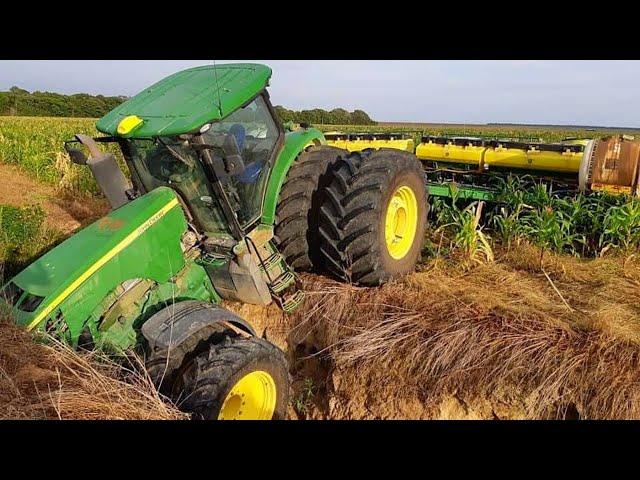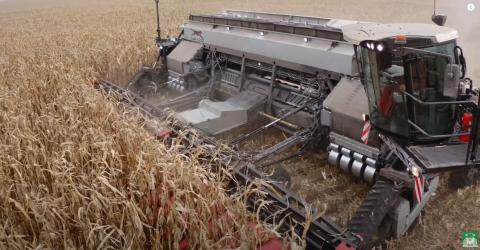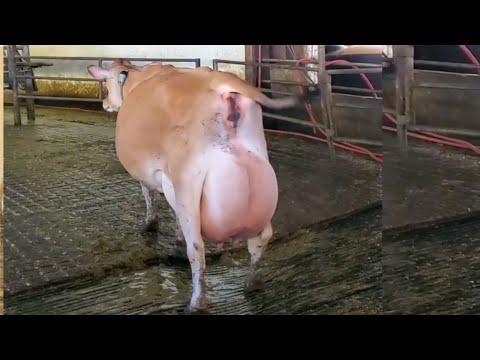Thanks for watching the video Awesome Technology.
#Modern #Machines In our country, wheat is mostly grown in the Central Anatolia region. For this reason, the region is also known as "Turkey's Wheat Warehouse".
Wheat grown in Turkey is very different in terms of species and varieties. Although the "durum" species and varieties were once overgrown, the production of more bread varieties has increased in the last 50 years.
However, the situation and the regions where soft wheats are grown have not changed much with the effect of natural conditions.
A - Bread wheats:
Bread wheat varieties grown in our country are generally white-yellow colored, small-grained, summer-winter sown and high starch content.
There are also red wheat, which is of the same variety but whose grain color is red and which is planted in winter, which is smaller grained and which is planted in summer, and which is called sünter.
B - Durum Wheats:
The durum wheat varieties of our country are named and grouped according to their growing in Thrace, Central Anatolia and South Anatolia Region.
The grains of this type of wheat are larger and their color is dark yellow and amber. Since it is desired to buy semolina from this type of wheat, those with more glassware grains are preferred.
Origin of Wheat:
Although the exact origin of wheat is not known, the arid highlands of Anatolia are shown as the homeland of wheat based on some available evidence. Currently, wild varieties of wheat are grown in Syria, Palestine and some parts of Anatolia.
It is not known exactly when, where and by whom the wheat was cultivated, that is, it began to be cultivated. What is known for sure is that wheat played an important role in the diet of the people in the past history of the Mediterranean countries.
It is claimed that barley was started to be used in public nutrition much earlier than wheat.
Classification of Wheat
Wheats are generally classified under 3 groups according to their botanical structure.
Durum Wheat (Triticum Durum)
Bread Wheat (Triticum Aestivum)
Topbas or Biscuit Wheat (Triticum Compactum)
In the wheat market, wheat is classified according to its other characteristics. For example ;
According to grain hardness
Hard Wheat
Soft Wheat
According to grain color
Red Wheat
White Wheat
According to their sowing
Summer Wheat
Winter Wheat
Wheat Production in Turkey:
Wheat is cultivated in every region of our country, which is suitable for the growing conditions of wheat, and it is in the first place in terms of cultivation and production. In our country, 83% of the cultivated areas allocated for field agriculture are covered by wheat. The average amount of wheat produced is over 18 million tons.
Appearance of Wheat:
A ) Color :
Wheat grain is in various colors such as white, light yellow, yellow red, amber and brown. Grain color comes from the seed coat, not the outer skin. Color is very important in the grain. In the USA, color is considered as a measure and class feature in the classification of wheats into classes and grades. The color of the grain is also important in that it indicates the wheat variety and gives an idea about the health of the stored wheat. While the color of durum wheat is dark brown and amber, bread wheats are mostly light colored such as white and yellow.
B ) Figure :
Shape of wheat: Wheat grain is elongated or round, in round shapes and in different sizes depending on the variety. The grain is 3-5 millimeters in length or 5-8 millimeters, and its width is between 1.5-2.5 or 2.5-4 millimeters. It is as if the grain is divided into two by the slit called the abdominal line extending from the front of the grain. The back is a little humped. There is a Germ-Embryo at the lower end of the grain, and beards on the upper side. The grain shape varies according to the variety. Durum wheats are large and long, bread rolls are smaller and more rounded.
C) Grain Structure:
Structure of Wheat Grain, parts of wheat grain
The wheat grain is mainly divided into three parts.
Shell (Pericarp-Bran) It constitutes 12% of the average grain.
Germ (Embryo-small) It constitutes 3% of the average grain.
Grain (endosperm-floury part) It constitutes 85% of the average grain.
These three parts differ from each other in terms of structure and function:
a ) Crust (Pericarp-dandruff):
The shell is the protective layer that surrounds the grain from the outside. This part is in three layers from the outside to the inside. Below them is the Aleuron layer. The aleuron layer and the bark part are separated as bran during grinding.
The epidermis cells form the outermost visible part of the shell. These cells have cutin and lignin in their outer membranes. The inside of the cell is filled with a waxy substance. This wax material does not imperme water and microbes into the grain.
The second layer under the epidermis is the seed coat (testa). It consists of two layers of brown colored cells.
The third layer is the Aleuron layer. Enzymes and vitamins and the color substances that give the characteristic color of wheat are also in these cells.
b ) My Germ (Embryo-small):
The second part of the wheat grain is Germ. It is located in the lower corner of the grain. It will be new in
- Category
- Tractor & Machinery












